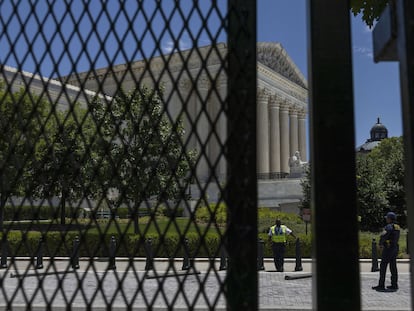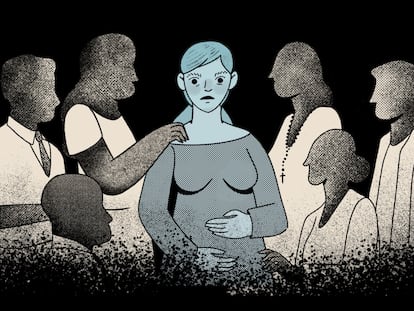A mother and daughter reflect on future of abortion in the US: Can the situation be turned around?
Agnieszka Paczynska and Nell Lyons discuss the new reality that the recent Supreme Court ruling brought for women’s rights

Agnieszka Paczynska, born in Poland 55 years ago, is an American woman who works as a professor of Political Science at George Mason University in Arlington, Virginia. She went to the United States in 1981 and, after living in several different cities across the country, settled in Washington, where her only daughter, Nell Lyons, an 18-year-old student, was born. Both define themselves as liberals in a city where that is the norm: 92.15% voted Democrat in the last elections. And both defend the right to abortion.
Paczynska says, proudly, that Lyons usually teaches her lessons when they discuss politics. The young woman admits that they normally agree, even if she is always a little more pessimistic; her mother admits that she does have reasons to be that way. While one has always taken the right to abortion for granted, the other is now facing a future in which the GOP aspires to sign a federal ban into law. For the time being, a recent ruling by the Supreme Court returned the authority to regulate on the subject to the individual states, overturning a half-century precedent set by the controversial ruling of Roe v. Wade. Now, 26 of the 50 states that make up the country are threatening to ban or severely restrict it.
The District of Columbia is not a state, but abortion is legal there. However, that could change too. Washington is ruled by the party that controls the House of Representatives, and the Republicans have hinted that they could ban abortion there if they take control, which could happen as early as November.
The decision of the court was not a surprise for them. It had been coming for years; essentially, since conservative Justice Brett Kavanaugh was appointed to the Supreme Court, where liberals face a 6-3 minority, something unprecedented since the 1930s. Indeed, it was only a matter of time.
Paczynska was impressed by the scope of the sentence, and found its selective and stern interpretation of history shocking. The concurring opinion of Justice Clarence Thomas, she adds, is particularly alarming, because it somehow brought other issues to the table, like gay marriage or contraception. “Some of the laws that have already been enacted throughout the country are placing women in precarious spots and leaving them unprotected, as the lines are not clear in cases like when a miscarriage, for example, is considered a crime,” she says.
Many doctors are not sure how far their treatment of a pregnant woman can go, Lyons points out. “How close to death does a person have to be before they are allowed to intervene? What is happening is terrible,” she notes. Lyons is also curious to see how they intend to deal with the claims already being made in some states by Jewish religious authorities. The scriptures say that a woman should have an abortion if she is at risk, whether physical or mental, so the ruling comes into conflict with the country’s religious freedom.
Most of the solutions that are being proposed by the Democratic Party, rather than actual solutions, are short-term patches, says Lyons. A long-term solution would involve actually resetting the system and starting over. Meanwhile – Paczynska adds – the Republicans have worked slowly and very strategically, playing their cards very well. She does not think there is much the Democrats can do; not with their prospects for November’s election, in which the ruling party usually loses seats. Something very extraordinary would have to happen.
Agnieszka finds the case of Mexico inspiring. There, the activists managed to turn the situation around. In that sense, the United States is a more complicated place – the very structure of such a large territory with so many laws makes it difficult to organize a joint action. The reality for a woman of reproductive age is very different in New York than it is in Louisiana. This is also common among neighboring states; for example, a 10-year-old girl who was raped in Ohio had to travel to Indiana in order to have an abortion. As much as this is an extreme case, it is one that reveals the uncertainty created by the new legislations.
Still, her natural tendencies towards optimism makes Paczynska think that a reconciliation between these two Americas is possible, even if not in the near future. She clings to the hope that most Americans are not part of that extremist camp that currently seems to dominate the Republican Party. Polls indicate that the majority support access to abortion, with more or less restrictions. The same goes for gun control. In the best case scenario, many of those who are disconnected from politics, those who may not even vote, could wake up when some of these new measures start to affect them directly. “Sometimes I doubt that both parties share the same reality. And it’s hard to fix a table when you can’t even agree on the fact that what you have before your eyes is... a table.”
Tu suscripción se está usando en otro dispositivo
¿Quieres añadir otro usuario a tu suscripción?
Si continúas leyendo en este dispositivo, no se podrá leer en el otro.
FlechaTu suscripción se está usando en otro dispositivo y solo puedes acceder a EL PAÍS desde un dispositivo a la vez.
Si quieres compartir tu cuenta, cambia tu suscripción a la modalidad Premium, así podrás añadir otro usuario. Cada uno accederá con su propia cuenta de email, lo que os permitirá personalizar vuestra experiencia en EL PAÍS.
¿Tienes una suscripción de empresa? Accede aquí para contratar más cuentas.
En el caso de no saber quién está usando tu cuenta, te recomendamos cambiar tu contraseña aquí.
Si decides continuar compartiendo tu cuenta, este mensaje se mostrará en tu dispositivo y en el de la otra persona que está usando tu cuenta de forma indefinida, afectando a tu experiencia de lectura. Puedes consultar aquí los términos y condiciones de la suscripción digital.
More information
Últimas noticias
Most viewed
- Sinaloa Cartel war is taking its toll on Los Chapitos
- Oona Chaplin: ‘I told James Cameron that I was living in a treehouse and starting a permaculture project with a friend’
- Reinhard Genzel, Nobel laureate in physics: ‘One-minute videos will never give you the truth’
- Why the price of coffee has skyrocketed: from Brazilian plantations to specialty coffee houses
- Silver prices are going crazy: This is what’s fueling the rally










































